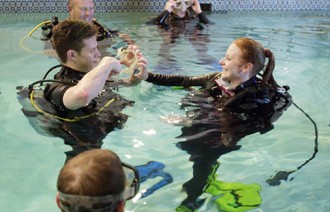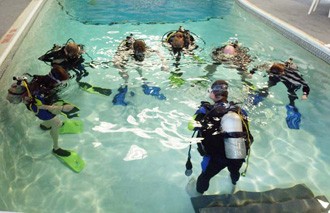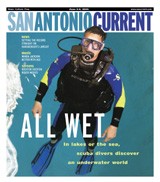'Tis the season for scuba diving in area lakes
"Seventy percent of our world is underwater," says Rick Wadle, owner of Dive World San Antonio. "Thirty percent of it we wander around and think we've seen everything, and we haven't."
Hollywood has done a lousy job of making the ocean appear friendly, adds Wadle, so he works hard to counteract irrational fears with good vibrations. Every year he presents a program titled "Dive World and Friends" to the University of Texas at San Antonio in which he promotes the ocean as a safe and fascinating environment. "Jaws is not down there waiting for you to jump in the water," Wadle jokes. "There's no giant squid that's going to squeeze you to death." Wadle also visits grade schools about once a month to explain scuba diving and show a short video that he filmed underwater in different parts of the world.
| Dive Master Jennifer Conley (right) helps novice diver Corey Smith with his mask during a scuba-diving session at Dive World on West Avenue. (Photos by Mark Greenberg) |
"Kids need something bright and positive to think about," says Wadle. "And let's face it, water is a concern. Our ocean is a concern. I think the more interest we can bring to that, the better we are."
Engineer Steve O'Neal, who has logged more than 100 hours under water since he began diving in 1973, says he would recommend diving to just about anyone. "If you ever tried snorkeling and enjoyed it, go for it! It's a completely different experience than anything else you've ever tried in your life, and it's safer than skydiving or bungee jumping."
This spring, Dive World is enticing novice divers to this little-seen waterworld with Discover Scuba, a free introductory lesson. Wadle says he initially began the promotion to attract more people to the water, but the timing turned out to be fortuitous. Some folks had tax refunds burning a hole in their pocket, and parents were beginning to look for summertime activities for their children.
"They're going to need something to do. It could be scuba diving this year," says Wadle. He says Discover Scuba is the same program offered to Boy Scouts of America. "We don't go out to the Scouts, the Scouts come to us and say, 'Could you do this for us?' So we make arrangements to bring them here eight to 10 at a time, and let them find out what scuba diving is all about."
The majority of Dive World's clientele comes from two groups: pre-family, ages 22-30, and families with older children. "There's a gap when they have kids, anywhere from 2 to 10 years old. We don't see that group. And then as soon as the kids are 10 or 11, we see them coming in again with families."
Wadle adds that many professionals with high-stress jobs, such as doctors and lawyers, become avid divers because it's an escape from their busy lives. "They're looking for ways to get away from some of their pressures and tensions," he says. "You can't take your problems underwater with you. They may come back in a hurry once you hit the surface, but diving is so encompassing that the rest of the world goes away."
O'Neal, who dives in area lakes, has also experienced some of the better bodies of water for divers, including those off Panama City, Florida, and Cozumel. "If you can go to the Caribbean to do some diving, you'll be hooked."
Wadle takes his students to Canyon and Medina Lakes for their open-water dives. Instructors in Corpus Christi also take their divers to these lakes. "It's not practical to take them out to the Gulf," Wadle says. "Diving in the Gulf calls for a boat trip of about 20 miles minimum to get out to where the water is blue and there is marine life."
In his classroom, Wadle displayed posters of divers in clear bodies of water that have almost infinite visibility. He laughs when asked how diving in local lakes compares to the pictures, and admits the lakes are not quite as clear. "All the ocean isn't this way either, by a long shot," he says. "If you were to go off in the beach in Corpus Christi, or anyplace down there, you'd notice you have better visibility in Medina Lake than you do down there." On a good day, divers may have 25 feet of visibility, says Wadle, but there are days when they can see clearly only 3 or 4 feet. There is still plenty of activity underneath these lakes, however. "Everyone looks forward to their Caribbean dive, to visibility like this," he adds, pointing to the posters. "But the people who have been diving for a long time, and do a lot of diving, still enjoy going into the freshwater lakes and seeing what's down there."
Wadle says he has noticed over the years that many of his divers never forget their instructors. As novices, they survived their first underwater breath, so a bond develops with the instructor. In order to prepare students for their first open-water dive, he says, they have to talk repeatedly about what the experience will be like. When the divers take their first jump, he says, it's important to reassure them that he is present because it helps them feel secure. "Diving is like a lot of other things.
If you have the right equipment and the right training, it's a very safe activity. But if you don't have the right equipment or the right training, it becomes less than totally safe."
Wadle says that most divers feel pure excitement when they have their first encounter with marine life. "They really become a part of it," he says. "You're not going to be scared, you're going to be excited. It will be an interacting thing."
Just when you thought it was safe to go back in the water, it actually is. •
By Chris Perez
|
Many area waters are scuba-suitable Dive World (403-3721) recommends: • Amistad Reservoir, in Del Rio on the Rio Grande, offers excellent visibility, marine life, and submerged ranch houses off its 800 miles of National Park Service-controlled shoreline. • Medina Lake, 25 miles west of San Antonio, also has good visibility in its deep waters, although much of the shoreline is privately owned, so divers often pay minimal access fees. Joe's Place, off Farm Road 1283, has campsites. Look for old fishing piers underwater. • North Park at Canyon Lake is a scenic area often used for training. Canyon is a deep lake with good visibility and plenty of fish. Deep Blue (930-1188) recommends: • Texas Flower gardens National Marine Sanctuary on the Texas-Louisiana border. Live on a boat for a weekend and dive. • Aquarena Springs in San Marcos is a naturally fed spring pool owned by Texas State University, which requires divers to take a $200 weekend course, but allows free use in exchange for volunteer hours thereafter. • Lake Travis is usually clearer and warmer than Canyon or Medina and has access areas set up specifically for divers. Dive Masters (684-3483) recommends: • Aquarena Springs scientific diver program, crystal-clear water, and warm temperature. • Diving 35 to 50 miles out from Texas oil rigs in various locations in Galveston and Port Aransas. Compiled by Nicole Chavez |
| Current Online news, politics, culture | |
| Diving basics
• Through June 15, Dive World San Antonio is offering Discover Scuba, a free introductory lesson to scuba diving. An introduction to breathing underwater and using some of the equipment. It typically costs $25. • Divers typically must complete 20 to 30 hours of classroom instruction and log additional time on open-water dives to become certified. • Anyone 15 or older can become certified. Children 12-14 can receive a Junior Open Water certification, which requires them to be accompanied by an adult certified diver in open water. • Scuba diving is not recommended for those who can't swim; some diving centers require prospective students to complete a 200-yard swim before enrolling. • People with certain medical conditions, such as chronic ear infection, epilepsy, claustrophobia, and asthma, are not encouraged to dive. | |
| |


















